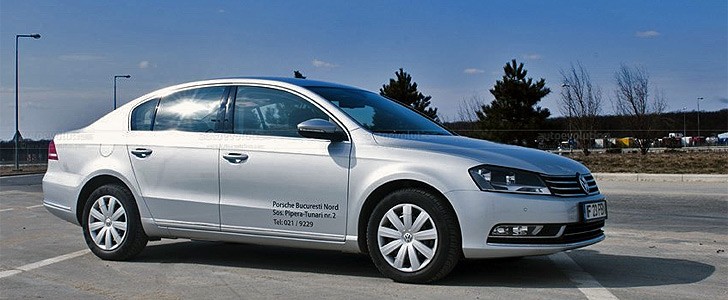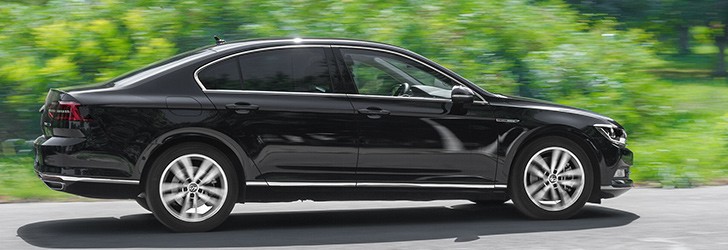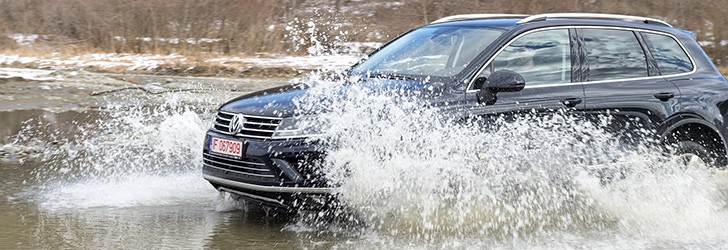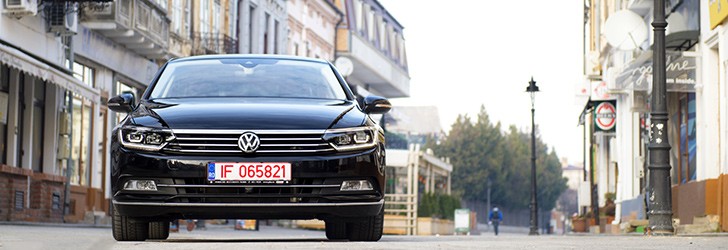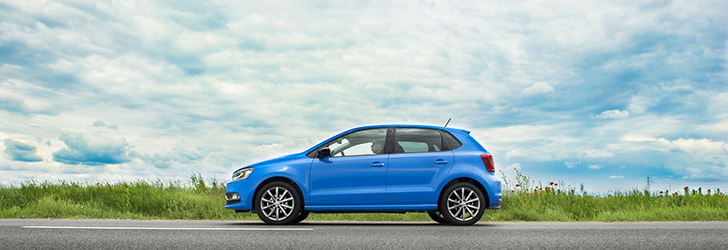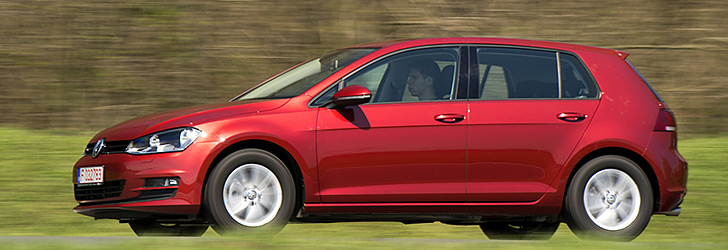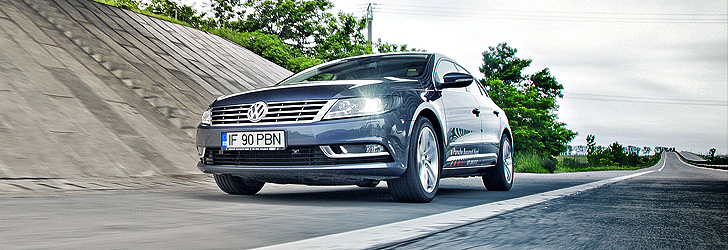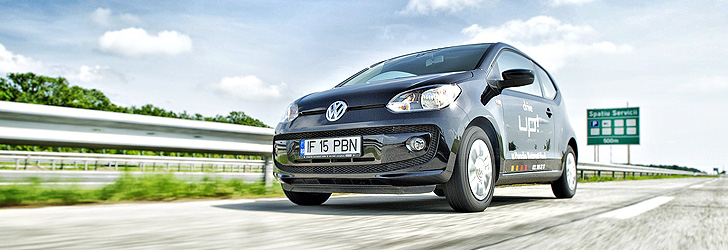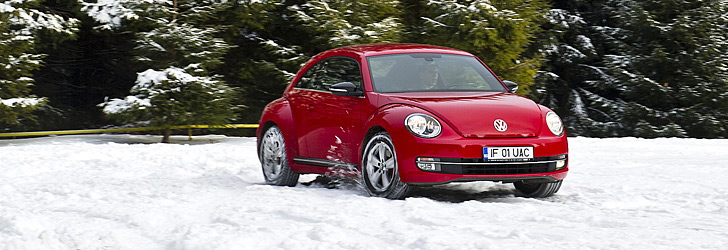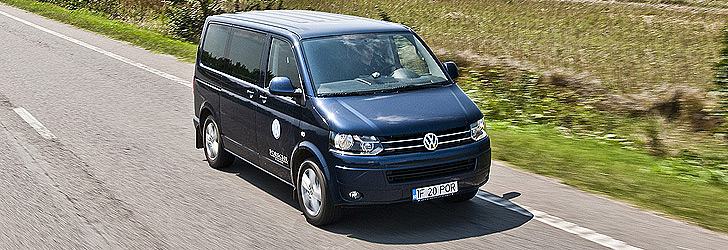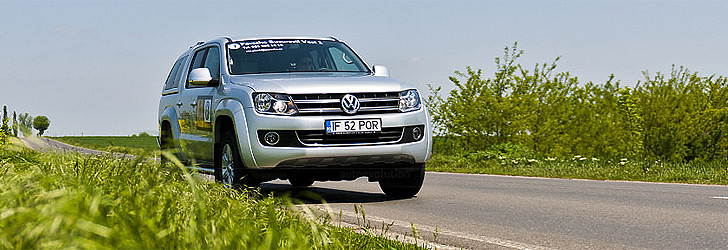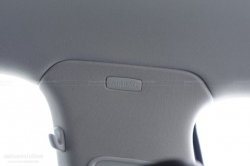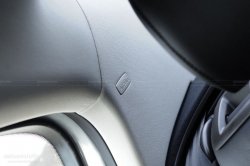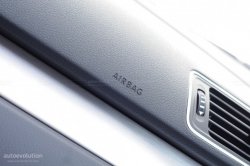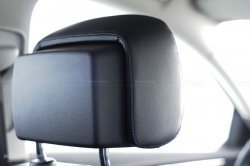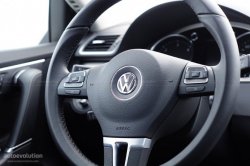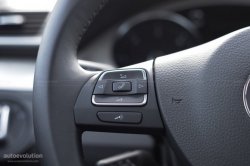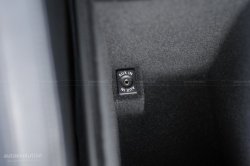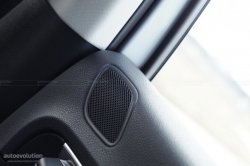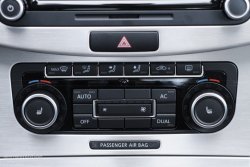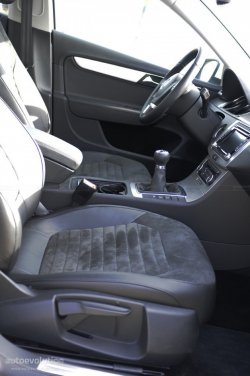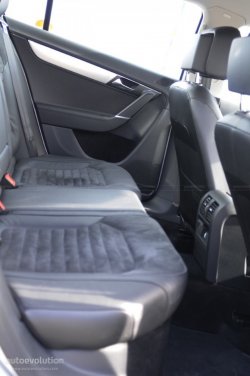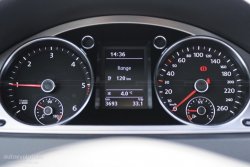VOLKSWAGEN Passat Review
OUR TEST CAR: VOLKSWAGEN Passat 2.0 TDI 140
The Passat is a Volkswagen and, up to a certain point, we could say that the Volkswagen is a Passat. You see, the midsize vehicle was the first of the new-age water-cooled VW models developed after the company married Audi in the 60s. We have to mention that Pagani isn’t the only automaker that names its creations after winds - VW has been doing this for decades: the company created the “Passat” designation using the German word for tradewind as a starting point. However, in Das Auto’s case, this bond is not mentioned too often as the majority of its vehicles come with a “no feelings, no emotions” attitude that is antithetic with such designations.
Right from the first generation of the model, Volkswagen fitted it with a diesel engine, but it wasn’t until the second generation (B2) that the Passat received an oil burner that had a phobia for gas stations. The B2 also used other fuel-pump repulsion developments, as it could be fitted with VW’s Formel E transmission, which used a long top gear and a freewheeling mechanism, as well as with a stop-start system.
The third incarnation of the Passat (B3) debuted Volkswagen’s famous “new is all-new” scheme in the early nineties, which saw the company introduce its successor, the B4, in the form of a serious facelift. In fact, the B4 was the first Passat to become the bearer of a TDI badge. Automotive engineering manuals at the time mentioned that an automobile should have an autonomy of around 800 km (around 500 miles). Well, the new Turbocharged Direct Injection powerplant allowed the Passat to travel 800... miles (about 1,300 km) on a single tank of fuel.
The Passat, which, by the way, dominated rivals such as the Opel Vectra over the years, became a mature vehicle with the arrival of the B5 generation, which used the same revamp scheme, but to a smaller extent, for the creation of the B5.5. By the time the latter arrived, “TDI” had already become some sort of a cult, with certain owners and forum users becoming obsessed by this three letters.
However, this generation also offered a goodie that, even though was embraced by few customers, offered it a black hole-like connection with the future Bugatti Veyron. When the 2000s were still infants, VW decided to replace the “V” in “V8” with a “W”, bringing a W8 engine under the Passat’s hood, with this being some sort of an ancestor for the Veyron’s W16 mill.
The B6 Passat hit the market in 2005, relying on the Golf’s skeleton. This generation brought a crucial change on the diesel side of the Passat range. We’re inviting you to step inside a dream within a dream here, as we’ll take a few moments to remember VW’s oil-burning ambitions.
Yes, we are literally talking about oil burning here. For years, the VW Group had been using the Pumpe Duse technology for its diesel engines. This was all fine and dandy, as each injector formed a happy couple with its pumping element, offering a high level of performance. However, at a certain point, the rest of the industry adopted the common-rail technology, with Volkswagen sticking to its pathway. While the performance offered by VW’s system was excellent, its efficiency and especially the refinement levels started falling behind compared to the assets offered by the common-rail system.
One rainy day when the B5.5 was already a big boy, VW realized that it cannot keep developing a technology all by itself and decided to switch to common rail. The 2.0-liter TDI unit, which had first been introduced on the B5.5, was converted to use this technology (with all the necessary adjustments being made) for the B6.
In 2008, the Germans introduced an unidentical twin for the B6, in the form of the Passat CC, Volkswagen's weapon for the four-door coupe segment, a slice of the market which tended to become much more that the niche it started out in life as.
Last year, VW decided that it was time for the world to meet Passat the Seventh. This is the Passat-est Passat to date. The Passat B7 closely studied its bloodline in the course of its major revamp and incorporated some of the top assets offered by its predecessors over the years, of course using contemporary tech to implement these. For example, it has brought back the stop-start system: all diesel units come with a stop-start system and with an energy recuperation one, wearing the BlueMotion badge. The refresh is focused on enhancing the Passat’s exterior, refinement and connection to the road.
We were blindfolded before we got into our test vehicle and, when we reached our first stop and were able to free ourselves, we found that we were offered a 140 hp 2.0 TDI model with a six-speed manual transmission, with the cake-icing Highline equipment level. Even though we were deprived of our vision, during the short initial ride we suspected that our car was wearing hiking boots and this was confirmed. The calendar said "March" and yet the car was still fitted with 205/55 R16 winter tires instead of its 235/45 R17 summer standard specification ones.
It is now to get to the reviewing business: creating... ahem... revamping a car for the contemporary European D segment is anything but an easy task, so let’s see how Volkswagen managed to handle this.
Many automotive producers are putting all their eggs in one design basket these days and Volkswagen Group is the strongest example of this “all for one and one for all” styling pathway. This infusion of visual similarity comes from the company’s Head of Design, Walter de’Silva, and the brand that leads the offensive is Volkswagen itself, which has spread its new visual identity to every model in its current range.
However, VW’s new family face, which emphasizes horizontal lines, does have its subcategories, with the comprehensive facelift received by the Passat bringing it into the “head office” one, which is shared with the (also heavily revamped) Phaeton. Oversaw by de’Silva, Klaus Bischoff, who leads VW’s design department, re-penned all the exterior areas of the Passat, except for the roof.
Like we said before, the Passat has become more of itself: these changes can bee seen as an evolved version of the exterior refresh scheme used for making the transition from the late 80s B3 to the early 90s B4 Passat. Back then, VW also redesigned the exterior, with the exception of the roof and the glasshouse, trying to present the car as an “all-new” rather than a facelifted one.
For the upper section of the Passat B7’s front end, the changes have brought a radiator grille with four chromed stripes, while the headlights’ overall shape now follows the line of the grille. Moving to the lower front fascia, we can see how the prominent chin used by more “volks”-orientated models, such as the Polo and Jetta, has been toned down. The lower line still dominates the area, but it is more subtle. Our test vehicle used the range-topping Highline equipment level, which brought an additional splash of chrome around the fog lights, with a thin line connecting them.
So, the Passat has ditched its oversized chrome mask, replacing it with the aforementioned elements, which create the impression that the car is wider. The car has actually kept its width (1,820mm/71.6 inches) and height (1,474mm/58 inches), gaining 4 mm (0.16 inches) in length.
We’ll run quickly past the side of the car, only mentioning that the new mirrors come with a dynamic design, integrating sleek turn signals. As ve’ve made one or two steps, we’ve almost reached the rear of the vehicle and we can now see the mirrors’ reflective surfaces. We wonder how that cool design translates into visibility, but we’ll answer that question in the "interior" chapter. One more step and we can now tell you that the design of the rear end is modern, fair and comes with well-placed elements, but doesn’t quite have a personality of its own. Hmm, this description could be extended to other areas of the car...
The design had to be kept inside the box, but a significant amount of work has gone into it, so the revamped Passat can be used as a business apparel. Consider this as being situated closer to Sergio Marchionne’s sweaters rather than to Stephan Winkelmann’s tailor-made suits.
The interior of the Passat can be seen as a portal to the inner self, as entering the car made us experience a deep emotion. No, the cabin doesn’t bring anything stunning to the game (it's a Passat, how could it have done that?). Actually, the emotion we felt when we entered the vehicle is special through the fact that it combines two moderate, but totally opposite, sensations.
We appreciate and disapprove of it at the same time, as it offers excellent ergonomics and makes everything clear, using precisely as many buttons as it is necessary, but does this relying on bits and pieces that come from the pre-facelift model or are shared with other vehicles wearing the VW badge.
So, you open the door, get a reminder of what you’re getting into (the “Passat” aluminum door sills take care of that) and climb into the driver’s seat, which, in our case, came finished in a combination of black Alcantara (used for the center of the seat) and leather. You can immediately find the proper position and start your journey.
Again, we were privileged, as the example we tested provided electric power for the driver seat’s reclining and lumbar support functions. Speaking of seats, the front ones do a pretty good job at relaxing you during long journeys, but could use some extra lateral support.
But this is not a driver’s car, and, this time only, we’re not saying this in a bad way. A journey in the Passat, can be enjoyed by any of the car’s passengers, as both the front and the rear space allow you to feel comfortable. Your luggage will be able to stretch its legs too, as the sedan comes with 565 liters of boot. The Passat makes you feel at home – literally, as it has learned a trick from its hatchback siblings. In the luggage compartment, you’ll find two levers that allow you to fold the upper section of the rear seats (asymmetrically) and fill the interior with whatever you need to take with you.
For the “additional storage spaces” chapter, we’ll mention that the ones in the front doors manage to rival black holes and that both the front and the rear armrests come with such features, with the latter armrest also offering an opening big enough to allow a supermodel to pass from the back seat to the trunk.
We must now return behind the wheel to tell you that the design of the exterior mirrors, which leaves quite a bit to be desired in terms of visibility, as we felt that we would’ve really preferred them to have a more conventional shape in order to benefit from a larger “Active” area - we’re especially referring to the lower corners here.
We didn’t necessarily plan to do this, but it happened. On its way from the lever that allows you to adjust the seat’s horizontal position to the gearstick, one of our hands hit the plastic that covers the steering column. This was an unfortunate event from the auditive point of view. Yes, a part of the interior elements, including the Phaeton-like analogue timepiece mounted just below the central air vents, give the impression that they are nothing but empty boxes when you physically interact with them.
All in all, the interior offers a cosy experience, with the “everything fits just fine” impression described earlier spreading to many details, such as the foot rest, which seems to be placed at just the right angle and distance.
We started the urban side of our evaluation in a parking lot... outside the city. We went there to press the reset button in our minds. Before we plunged into the roaring city traffic, we noticed that the vehicle was rather shy at flexing its wheels. Even though the maximum steering angle looked modest, this didn’t seem to affect parking maneuvers or give the car a turn radius outside of the class’ average.
Even though we are talking about a vehicle that tips the scales at about one and a half tons (3,300 lbs), the Passat feels at home on our crowded city streets. The steering, which is even lighter that the previous model’s one, allows you to dance through the morning madness, with the 320 Nm maximum torque, which is available between 1,750 and 2,500 rpm, contributing to the positive feeling. We would’ve liked the torque band to be wider, but the precise shifts offered by the six-speed manual compensate for this.
Inside the city, you usually find yourself in one of the first three gears, with the six speed manual having just the right gearing for these ones: not too long, but no too short either. The clutch proved to be a friendly bloke and showed us that it has a good relationship with the stop-start system. The latter proved to be a perfect organ for the Passat and it didn’t just have a psychological impact. Tackling the early morning rush hour, we managed to achieve a fuel consumption of 8 liters per 100 km (29.4 US mpg), without having to make any compromise, such as turn the air conditioning off.
In fact, the Passat manages to make it to the podium of its class in terms of fuel efficiency. It’s hard to compare test drive figures, as the traffic is never the same, so we’ll suppose that all carmakers manipulate the truth to the same extent and tell you that the Passat offers official fuel efficiency figures that sit at the top floor of the segment. According to VW, the Passat B7 needs 5.6 liters of diesel to cover 100 km of urban roads (42 US mpg).
So, you’re an owner. You know that your car has “frugal” written all over it so you set off in a relaxed mood - what’s the first thing that you feel? Well, the frontal visibility is OK, allowing you to keep your state of mind. However, turning your head to the rear will make you sweat a little bit, as the C-pillars aren’t quite aware of the fact that the driver also needs rear visibility. As for the mirrors, they also bring a mix of emotions: while the interior one serves its purpose just fine, the shape of the exterior ones affects the visibility. Our test car was fitted with auto-dimming mirrors (the interior and the exterior one on the driver’s side), which really make a difference.
Roads should be perfect stretches of asphalt that make every journey a delights. Unfortunately, the real world is far from offering us that and the crowded cities make it more and more difficult for the driver to avoid potholes or notice imperfections. Fortunately, from the moment the wheel moves, you feel that the German engineers have been well paid, as the Passat acts as a shield, protecting you from everything the urban roads throw at you.
The vehicle we tested came fitted with front and rear parking sensors, using the generous (touch-screen) display of its RCD 300 entertainment system, as well as acoustic signals (which can be deactivated) to guide the driver. We tested the system’s limits - here’s what we found: when the graphics inform you that you’ve reached the “game over” status, the actual distance to the object that threatens to become one with your vehicle is about 8 cm (3 inches). No, your lawyer can’t quote us.
As for the shopping trips, the Passat seems to be perfect for this type of adventures. You’re busy all day at the office and really don’t have time for the gym. So you choose to buy a set of weights to play with at home. Just worry about your bench press capability, transporting them will be no problem with the Passat. And if you’ve just melted your credit card and feel guilty for holding one too many bags, placing these in the humongous luggage compartment (it's pretty hard to fill all 566 liters of it, trust us) will make them seem like crumbs, bringing back the pleasant feeling we were talking about earlier.
The boot-opening button on the key, carried over from the B6, is a handy function. Speaking of "boot", the Passat has one more trick up its sleeve. Actually, we should use the “pant sleeve” for this one: a special system allows you to open the boot lid by placing your foot under the rear bumper - we can't tell you how well this feature actually works, as our test car hadn't been gifted with it.
The Passat is an animal that is pretty well adapted for the urban jungle, with the frugality, decent dynamics and high level of comfort weighing a million times more than the few visibility issues and the rather dull interior.
The Volkswagen Group’s 2.0-liter TDI engine needs no presentation. The B7 Passat manages to make the most out of the powerplant’s efficiency, regardless of the fact that the road you are driving on is surrounded by buildings, trees or guard rails. While in the city you get moderate gearing, as you mainly use the first three gears, the open road will see you work with the relatively long gearing offered by the rest of the transmission.
This helps the Passat avoid refuels, but it won’t turn it into an Autobahn blitzer. But don’t get us wrong, you don’t necessarily need the 170 hp version of the engine - our test car’s muscles were enough to provide decent performance for the targeted audience.
You need just under 10 seconds (9.8 to be more precise) to hit 100 km/h (62 mph), while the top speed sits at 213 km/h (132.5 mph). Between these speeds, the engine is able to show you that it can understand what your right foot is trying to say. However, in many cases, the long gearing means that you need to downshift in order to deal with overtaking.
The gearing is not the only twin-faced side of the Passat, as the same duality is shown by the steering. During city driving, the light steering is OK, as it allows you to tackle the heavy traffic, but when you exit the urban area and you build up some speed, this becomes a the weak point of the car.
It manages to convince the front wheels to follow your lead, but that’s about it. This is a one-way street: once your intentions are translated to the road the story ends, there’s no feedback. While this is enough both for city driving and for open road episodes that have conservative drivers in the main roles, we were curios to see what happens when the 18-year old son steals his dad’s keys.
We started our adventure outside public roads, in a deserted parking lot. The dusty tarmac exaggerated the vehicle’s dynamic tendencies, just like getting your skin wet allows you to feel everything more intense (since this is a review, we recommend ginger massage oil for testing the latter statement).
We deactivated the ESP and got down and dirty. We tried pretty hard to make the Passat’s rear end step out at city speeds plus a few tens of kilometers per hour, but the car staid focused, refusing to completely lose it. We applauded and returned to the open road. The twisty open road to be more specific. As you can imagine, the vehicle’s serious understeering tendencies quickly determined us to quit trying to pilot the car.
One thing is clear: the Germans didn’t intended to make the Passat offer a sporty feeling. We’re pretty sure that if they had wanted to, we would’ve ended up with a decent play partner. As we found out, there’s a strong argument that supports this: (again outside public roads), we tried to shoot at the vehicle’s composure by flicking the wheel at frightening speeds. The suspension, together with the ESP (when it was activated), did a wonderful job at keeping things together, offering us a lot of confidence for normal driving. However, the evaluation process was distorted by the winter tires, which really couldn't take the punishment.
Occasionally, we had to ditch some of the vehicle's speed, with this kind of efforts showing us that the vehicle's brakes really deserve a set of applause (yes, we know, this is the second one). The stopping power is good, but what really impresses is the fade resistance.
Want to hear a really good one: even during this rather extreme testing conditions, the suspension managed to keep our bodies isolated from the road’s flaws. What can we say? It’s such a shame to feel that the chassis has unexploited potential. However, most Passat buyers probably don’t care about this. But maybe this sort of involving driving experience would grow on a part of them if VW decided to sprinkle some spice over the Passat...
Speaking of normal driving, we ended our handling quest in order to introduce the Passat to the highway. Volkswagen promises a fuel efficiency of 4.1 liters (57.4 mpg) for this environment. Introduced in autoevolution’s reality frame, the vehicle returned a highway fuel efficiency of 5.7 liters per 100 km (41 US mpg) for a 130 km/h (80 mph) cruise, using the sixth element of the gearbox.
All in all, the Passat proves to be able to cater for your long distance travel needs, doing this in a way that keeps you relaxed, but without moving one muscle on your face.
Right from the first generation of the model, Volkswagen fitted it with a diesel engine, but it wasn’t until the second generation (B2) that the Passat received an oil burner that had a phobia for gas stations. The B2 also used other fuel-pump repulsion developments, as it could be fitted with VW’s Formel E transmission, which used a long top gear and a freewheeling mechanism, as well as with a stop-start system.
The third incarnation of the Passat (B3) debuted Volkswagen’s famous “new is all-new” scheme in the early nineties, which saw the company introduce its successor, the B4, in the form of a serious facelift. In fact, the B4 was the first Passat to become the bearer of a TDI badge. Automotive engineering manuals at the time mentioned that an automobile should have an autonomy of around 800 km (around 500 miles). Well, the new Turbocharged Direct Injection powerplant allowed the Passat to travel 800... miles (about 1,300 km) on a single tank of fuel.
The Passat, which, by the way, dominated rivals such as the Opel Vectra over the years, became a mature vehicle with the arrival of the B5 generation, which used the same revamp scheme, but to a smaller extent, for the creation of the B5.5. By the time the latter arrived, “TDI” had already become some sort of a cult, with certain owners and forum users becoming obsessed by this three letters.
However, this generation also offered a goodie that, even though was embraced by few customers, offered it a black hole-like connection with the future Bugatti Veyron. When the 2000s were still infants, VW decided to replace the “V” in “V8” with a “W”, bringing a W8 engine under the Passat’s hood, with this being some sort of an ancestor for the Veyron’s W16 mill.
The B6 Passat hit the market in 2005, relying on the Golf’s skeleton. This generation brought a crucial change on the diesel side of the Passat range. We’re inviting you to step inside a dream within a dream here, as we’ll take a few moments to remember VW’s oil-burning ambitions.
Yes, we are literally talking about oil burning here. For years, the VW Group had been using the Pumpe Duse technology for its diesel engines. This was all fine and dandy, as each injector formed a happy couple with its pumping element, offering a high level of performance. However, at a certain point, the rest of the industry adopted the common-rail technology, with Volkswagen sticking to its pathway. While the performance offered by VW’s system was excellent, its efficiency and especially the refinement levels started falling behind compared to the assets offered by the common-rail system.
One rainy day when the B5.5 was already a big boy, VW realized that it cannot keep developing a technology all by itself and decided to switch to common rail. The 2.0-liter TDI unit, which had first been introduced on the B5.5, was converted to use this technology (with all the necessary adjustments being made) for the B6.
In 2008, the Germans introduced an unidentical twin for the B6, in the form of the Passat CC, Volkswagen's weapon for the four-door coupe segment, a slice of the market which tended to become much more that the niche it started out in life as.
Last year, VW decided that it was time for the world to meet Passat the Seventh. This is the Passat-est Passat to date. The Passat B7 closely studied its bloodline in the course of its major revamp and incorporated some of the top assets offered by its predecessors over the years, of course using contemporary tech to implement these. For example, it has brought back the stop-start system: all diesel units come with a stop-start system and with an energy recuperation one, wearing the BlueMotion badge. The refresh is focused on enhancing the Passat’s exterior, refinement and connection to the road.
We were blindfolded before we got into our test vehicle and, when we reached our first stop and were able to free ourselves, we found that we were offered a 140 hp 2.0 TDI model with a six-speed manual transmission, with the cake-icing Highline equipment level. Even though we were deprived of our vision, during the short initial ride we suspected that our car was wearing hiking boots and this was confirmed. The calendar said "March" and yet the car was still fitted with 205/55 R16 winter tires instead of its 235/45 R17 summer standard specification ones.
It is now to get to the reviewing business: creating... ahem... revamping a car for the contemporary European D segment is anything but an easy task, so let’s see how Volkswagen managed to handle this.
Many automotive producers are putting all their eggs in one design basket these days and Volkswagen Group is the strongest example of this “all for one and one for all” styling pathway. This infusion of visual similarity comes from the company’s Head of Design, Walter de’Silva, and the brand that leads the offensive is Volkswagen itself, which has spread its new visual identity to every model in its current range.
However, VW’s new family face, which emphasizes horizontal lines, does have its subcategories, with the comprehensive facelift received by the Passat bringing it into the “head office” one, which is shared with the (also heavily revamped) Phaeton. Oversaw by de’Silva, Klaus Bischoff, who leads VW’s design department, re-penned all the exterior areas of the Passat, except for the roof.
Like we said before, the Passat has become more of itself: these changes can bee seen as an evolved version of the exterior refresh scheme used for making the transition from the late 80s B3 to the early 90s B4 Passat. Back then, VW also redesigned the exterior, with the exception of the roof and the glasshouse, trying to present the car as an “all-new” rather than a facelifted one.
For the upper section of the Passat B7’s front end, the changes have brought a radiator grille with four chromed stripes, while the headlights’ overall shape now follows the line of the grille. Moving to the lower front fascia, we can see how the prominent chin used by more “volks”-orientated models, such as the Polo and Jetta, has been toned down. The lower line still dominates the area, but it is more subtle. Our test vehicle used the range-topping Highline equipment level, which brought an additional splash of chrome around the fog lights, with a thin line connecting them.
So, the Passat has ditched its oversized chrome mask, replacing it with the aforementioned elements, which create the impression that the car is wider. The car has actually kept its width (1,820mm/71.6 inches) and height (1,474mm/58 inches), gaining 4 mm (0.16 inches) in length.
We’ll run quickly past the side of the car, only mentioning that the new mirrors come with a dynamic design, integrating sleek turn signals. As ve’ve made one or two steps, we’ve almost reached the rear of the vehicle and we can now see the mirrors’ reflective surfaces. We wonder how that cool design translates into visibility, but we’ll answer that question in the "interior" chapter. One more step and we can now tell you that the design of the rear end is modern, fair and comes with well-placed elements, but doesn’t quite have a personality of its own. Hmm, this description could be extended to other areas of the car...
The design had to be kept inside the box, but a significant amount of work has gone into it, so the revamped Passat can be used as a business apparel. Consider this as being situated closer to Sergio Marchionne’s sweaters rather than to Stephan Winkelmann’s tailor-made suits.
The interior of the Passat can be seen as a portal to the inner self, as entering the car made us experience a deep emotion. No, the cabin doesn’t bring anything stunning to the game (it's a Passat, how could it have done that?). Actually, the emotion we felt when we entered the vehicle is special through the fact that it combines two moderate, but totally opposite, sensations.
We appreciate and disapprove of it at the same time, as it offers excellent ergonomics and makes everything clear, using precisely as many buttons as it is necessary, but does this relying on bits and pieces that come from the pre-facelift model or are shared with other vehicles wearing the VW badge.
So, you open the door, get a reminder of what you’re getting into (the “Passat” aluminum door sills take care of that) and climb into the driver’s seat, which, in our case, came finished in a combination of black Alcantara (used for the center of the seat) and leather. You can immediately find the proper position and start your journey.
Again, we were privileged, as the example we tested provided electric power for the driver seat’s reclining and lumbar support functions. Speaking of seats, the front ones do a pretty good job at relaxing you during long journeys, but could use some extra lateral support.
But this is not a driver’s car, and, this time only, we’re not saying this in a bad way. A journey in the Passat, can be enjoyed by any of the car’s passengers, as both the front and the rear space allow you to feel comfortable. Your luggage will be able to stretch its legs too, as the sedan comes with 565 liters of boot. The Passat makes you feel at home – literally, as it has learned a trick from its hatchback siblings. In the luggage compartment, you’ll find two levers that allow you to fold the upper section of the rear seats (asymmetrically) and fill the interior with whatever you need to take with you.
For the “additional storage spaces” chapter, we’ll mention that the ones in the front doors manage to rival black holes and that both the front and the rear armrests come with such features, with the latter armrest also offering an opening big enough to allow a supermodel to pass from the back seat to the trunk.
We must now return behind the wheel to tell you that the design of the exterior mirrors, which leaves quite a bit to be desired in terms of visibility, as we felt that we would’ve really preferred them to have a more conventional shape in order to benefit from a larger “Active” area - we’re especially referring to the lower corners here.
We didn’t necessarily plan to do this, but it happened. On its way from the lever that allows you to adjust the seat’s horizontal position to the gearstick, one of our hands hit the plastic that covers the steering column. This was an unfortunate event from the auditive point of view. Yes, a part of the interior elements, including the Phaeton-like analogue timepiece mounted just below the central air vents, give the impression that they are nothing but empty boxes when you physically interact with them.
All in all, the interior offers a cosy experience, with the “everything fits just fine” impression described earlier spreading to many details, such as the foot rest, which seems to be placed at just the right angle and distance.
We started the urban side of our evaluation in a parking lot... outside the city. We went there to press the reset button in our minds. Before we plunged into the roaring city traffic, we noticed that the vehicle was rather shy at flexing its wheels. Even though the maximum steering angle looked modest, this didn’t seem to affect parking maneuvers or give the car a turn radius outside of the class’ average.
Even though we are talking about a vehicle that tips the scales at about one and a half tons (3,300 lbs), the Passat feels at home on our crowded city streets. The steering, which is even lighter that the previous model’s one, allows you to dance through the morning madness, with the 320 Nm maximum torque, which is available between 1,750 and 2,500 rpm, contributing to the positive feeling. We would’ve liked the torque band to be wider, but the precise shifts offered by the six-speed manual compensate for this.
Inside the city, you usually find yourself in one of the first three gears, with the six speed manual having just the right gearing for these ones: not too long, but no too short either. The clutch proved to be a friendly bloke and showed us that it has a good relationship with the stop-start system. The latter proved to be a perfect organ for the Passat and it didn’t just have a psychological impact. Tackling the early morning rush hour, we managed to achieve a fuel consumption of 8 liters per 100 km (29.4 US mpg), without having to make any compromise, such as turn the air conditioning off.
In fact, the Passat manages to make it to the podium of its class in terms of fuel efficiency. It’s hard to compare test drive figures, as the traffic is never the same, so we’ll suppose that all carmakers manipulate the truth to the same extent and tell you that the Passat offers official fuel efficiency figures that sit at the top floor of the segment. According to VW, the Passat B7 needs 5.6 liters of diesel to cover 100 km of urban roads (42 US mpg).
So, you’re an owner. You know that your car has “frugal” written all over it so you set off in a relaxed mood - what’s the first thing that you feel? Well, the frontal visibility is OK, allowing you to keep your state of mind. However, turning your head to the rear will make you sweat a little bit, as the C-pillars aren’t quite aware of the fact that the driver also needs rear visibility. As for the mirrors, they also bring a mix of emotions: while the interior one serves its purpose just fine, the shape of the exterior ones affects the visibility. Our test car was fitted with auto-dimming mirrors (the interior and the exterior one on the driver’s side), which really make a difference.
Roads should be perfect stretches of asphalt that make every journey a delights. Unfortunately, the real world is far from offering us that and the crowded cities make it more and more difficult for the driver to avoid potholes or notice imperfections. Fortunately, from the moment the wheel moves, you feel that the German engineers have been well paid, as the Passat acts as a shield, protecting you from everything the urban roads throw at you.
The vehicle we tested came fitted with front and rear parking sensors, using the generous (touch-screen) display of its RCD 300 entertainment system, as well as acoustic signals (which can be deactivated) to guide the driver. We tested the system’s limits - here’s what we found: when the graphics inform you that you’ve reached the “game over” status, the actual distance to the object that threatens to become one with your vehicle is about 8 cm (3 inches). No, your lawyer can’t quote us.
As for the shopping trips, the Passat seems to be perfect for this type of adventures. You’re busy all day at the office and really don’t have time for the gym. So you choose to buy a set of weights to play with at home. Just worry about your bench press capability, transporting them will be no problem with the Passat. And if you’ve just melted your credit card and feel guilty for holding one too many bags, placing these in the humongous luggage compartment (it's pretty hard to fill all 566 liters of it, trust us) will make them seem like crumbs, bringing back the pleasant feeling we were talking about earlier.
The boot-opening button on the key, carried over from the B6, is a handy function. Speaking of "boot", the Passat has one more trick up its sleeve. Actually, we should use the “pant sleeve” for this one: a special system allows you to open the boot lid by placing your foot under the rear bumper - we can't tell you how well this feature actually works, as our test car hadn't been gifted with it.
The Passat is an animal that is pretty well adapted for the urban jungle, with the frugality, decent dynamics and high level of comfort weighing a million times more than the few visibility issues and the rather dull interior.
The Volkswagen Group’s 2.0-liter TDI engine needs no presentation. The B7 Passat manages to make the most out of the powerplant’s efficiency, regardless of the fact that the road you are driving on is surrounded by buildings, trees or guard rails. While in the city you get moderate gearing, as you mainly use the first three gears, the open road will see you work with the relatively long gearing offered by the rest of the transmission.
This helps the Passat avoid refuels, but it won’t turn it into an Autobahn blitzer. But don’t get us wrong, you don’t necessarily need the 170 hp version of the engine - our test car’s muscles were enough to provide decent performance for the targeted audience.
You need just under 10 seconds (9.8 to be more precise) to hit 100 km/h (62 mph), while the top speed sits at 213 km/h (132.5 mph). Between these speeds, the engine is able to show you that it can understand what your right foot is trying to say. However, in many cases, the long gearing means that you need to downshift in order to deal with overtaking.
The gearing is not the only twin-faced side of the Passat, as the same duality is shown by the steering. During city driving, the light steering is OK, as it allows you to tackle the heavy traffic, but when you exit the urban area and you build up some speed, this becomes a the weak point of the car.
It manages to convince the front wheels to follow your lead, but that’s about it. This is a one-way street: once your intentions are translated to the road the story ends, there’s no feedback. While this is enough both for city driving and for open road episodes that have conservative drivers in the main roles, we were curios to see what happens when the 18-year old son steals his dad’s keys.
We started our adventure outside public roads, in a deserted parking lot. The dusty tarmac exaggerated the vehicle’s dynamic tendencies, just like getting your skin wet allows you to feel everything more intense (since this is a review, we recommend ginger massage oil for testing the latter statement).
We deactivated the ESP and got down and dirty. We tried pretty hard to make the Passat’s rear end step out at city speeds plus a few tens of kilometers per hour, but the car staid focused, refusing to completely lose it. We applauded and returned to the open road. The twisty open road to be more specific. As you can imagine, the vehicle’s serious understeering tendencies quickly determined us to quit trying to pilot the car.
One thing is clear: the Germans didn’t intended to make the Passat offer a sporty feeling. We’re pretty sure that if they had wanted to, we would’ve ended up with a decent play partner. As we found out, there’s a strong argument that supports this: (again outside public roads), we tried to shoot at the vehicle’s composure by flicking the wheel at frightening speeds. The suspension, together with the ESP (when it was activated), did a wonderful job at keeping things together, offering us a lot of confidence for normal driving. However, the evaluation process was distorted by the winter tires, which really couldn't take the punishment.
Occasionally, we had to ditch some of the vehicle's speed, with this kind of efforts showing us that the vehicle's brakes really deserve a set of applause (yes, we know, this is the second one). The stopping power is good, but what really impresses is the fade resistance.
Want to hear a really good one: even during this rather extreme testing conditions, the suspension managed to keep our bodies isolated from the road’s flaws. What can we say? It’s such a shame to feel that the chassis has unexploited potential. However, most Passat buyers probably don’t care about this. But maybe this sort of involving driving experience would grow on a part of them if VW decided to sprinkle some spice over the Passat...
Speaking of normal driving, we ended our handling quest in order to introduce the Passat to the highway. Volkswagen promises a fuel efficiency of 4.1 liters (57.4 mpg) for this environment. Introduced in autoevolution’s reality frame, the vehicle returned a highway fuel efficiency of 5.7 liters per 100 km (41 US mpg) for a 130 km/h (80 mph) cruise, using the sixth element of the gearbox.
All in all, the Passat proves to be able to cater for your long distance travel needs, doing this in a way that keeps you relaxed, but without moving one muscle on your face.
12
Our VOLKSWAGEN Testdrives:
Photo gallery (123)
